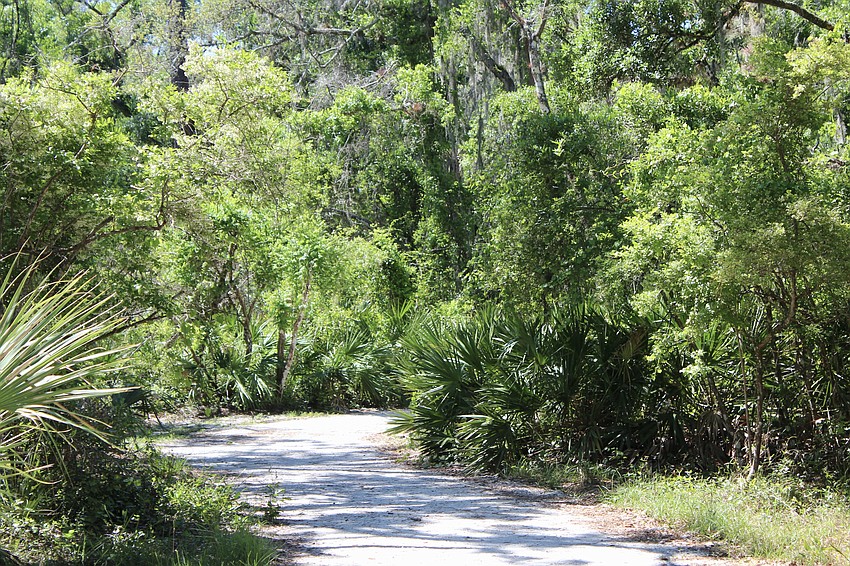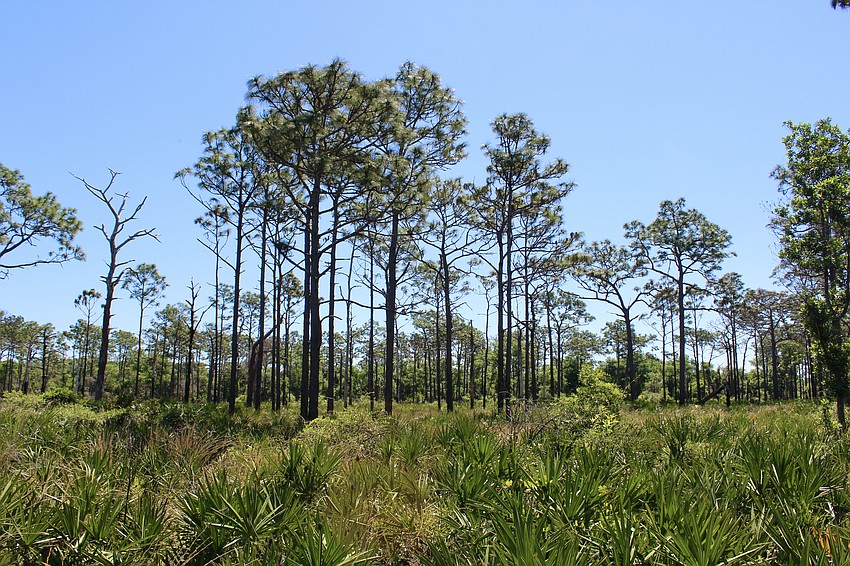- May 1, 2025
-
-
Loading

Loading

Brenda Russell is ready to get her back brace off and take a walk through the Johnson Preserve at Braden River.
Years before Russell had to undergo back surgery, she figuratively broke her back working to save the land from development.
The community effort resulted in a 44-acre preserve nestled between the River Club and Braden Woods, where Russell can see the preserve from her front yard.
“I’m anxious to go,” she said. “I see cars in the parking lot regularly. Even before it was finished, it was being used by the community, but it’s definitely being used more now.”
The preserve has been open to the public since shortly after Manatee County purchased the property for $3 million in 2018. But now, the amenities are complete.
The dirt trail was shelled, and a parking lot and pavilion were constructed. The only thing left to install is an information kiosk and sign dedicated to the man who got the project started, Carl Bergstresser.

The 44-acres were formed from four parcels. Bergstresser donated his parcel to the Conservation Foundation upon his death from pancreatic cancer in 2016. The county purchased the other three parcels from Myarra Property Joint Venture, owned by developer Pat Neal.
Neal had plans to build 32 homes on his three parcels.
“(Johnson Preserve) was kind of like, here’s the playbook of how citizens can work together with not-for-profit and government to affect positive change in their community,” said Christine Johnson, president of the Conservation Foundation of the Gulf Coast.
“It was intense for several years there,” Russell said. “It was like another full-time job.”
She and about 25 other neighbors were the force behind Keep Woods, a resident group aimed at preserving the parcels.
They held weekly meetings, started a website, knocked on doors, collected signatures for a petition, made yard signs and handed out pamphlets at community events.
“They formed a 501(c)(3),” Johnson said. “And there were leaders in that community who really put in the time and were boots on the ground while the Conservation Foundation worked with Manatee County staff and commissioners.”
Commissioners agreed to buy the property, but only if the foundation contributed $1 million.

The county’s request was made in 2018, before the 2020 referendum that uses taxpayer dollars to fund the purchase of conservation lands had been passed. The foundation didn’t have a land trust to draw funds from either.
The intensity continued for six more weeks after commissioners agreed to buy the property. Johnson said donations came from as far away as Alachua County. Instead of raising $1 million, the foundation raised nearly $1.3 million.
The name of the preserve stems from a $500,000 grant that was awarded to the Conservation Foundation by the Floyd C. Johnson & Flo Singer Johnson Foundation.
The following year, the Conservation Foundation started a land trust, which is holding just under $1 million right now. The trust has been used to fund five properties since 2019.
Properties that eventually will be bought by the state or a municipality are prioritized. If red tape is holding up a purchase, the foundation can step in to secure the property before it’s lost.
While negotiations for Johnson Preserve took about 18 months, the property was saved from development because Neal was approached before his plans were too far down the pipeline to stop.
“When the contracts are already done with the developer and they’re starting construction, it’s too late,” Johnson said. “People need to be aware of what’s going on in their community long before the bull dozers come out.”
The Conservation Foundation and Manatee County’s Environmental Lands Management and Acquisition Committee only deal with willing landowners, but staff and committee members actively seek out properties.
They also seek out funding sources on the state and federal levels.
Bergstresser’s donation is not the standard, but Johnson said donations of land are becoming more common in estate planning as development progresses.
“People want balance. As more development happens, the more they want conservation,” Johnson said. “We’re working in Southwest Florida in a race against time to keep that balance between development and conservation. Not everything should be conserved, and not everything should be developed.”
This particular project mattered to neighbors for both sentimental and practical reasons. Bergstresser’s property was part of the original tract of land purchased for the Linger Lodge.
“His grandparents were the founders of the Linger Lodge,” Russell said. “There was a real connection and community history with that property.”
Russell also said neighbors have seen the property flood. Had the land been developed, a floodplain buffer would have been eliminated.
The result of the community’s efforts is 44 acres of perpetual tranquility. The conservation easement prevents additional structures from being built, and tree removal is prohibited unless the trees are invasive.
The county still has some restoration work underway. After three prescribed burns, staff continues to remove invasive species and reseed native grasses and wildflowers.
The amenities are minimal to keep the land as undisturbed as possible. Signs direct visitors to stay on the trail, which circles around wildlife habitats, instead of weaving in and out of them. Large tracts remain untouched, including wetlands.
The animals kept their habitats, and the people and dogs gained a scenic walking route and a kayak launch. The launch requires walking or wheeling the kayak a couple hundred yards to the river from the parking lot.

There are two picnic tables under the pavilion and a bench at the end of the dirt trail that leads to the river. That’s it. The rest of the preserve is for wildlife.
Gopher tortoises, which are a “threatened” species protected by the state, have burrows in the preserve. Swallow-tailed kites have also been spotted. The kites are raptors with distinguishing black and white markings and forked tails.
According to the Florida Fish and Wildlife Conservation Commission, kites spend the fall and winter months in South America. They arrive in Florida in early March to breed. Look out for the raptors when circling the pine forest. Tall pine trees are among their favorite nesting spots.
Bergstresser’s house is still standing, too. Park Ranger Clayton McCurry lives there now, so someone is always on site.
“We met (Pat Neal's) rather high price for the property, but he could have refused to sell to us,” Russell said. “A lot of people said he never would, but we appealed to his better angels. A lot of effort was put in to bring this to reality.”